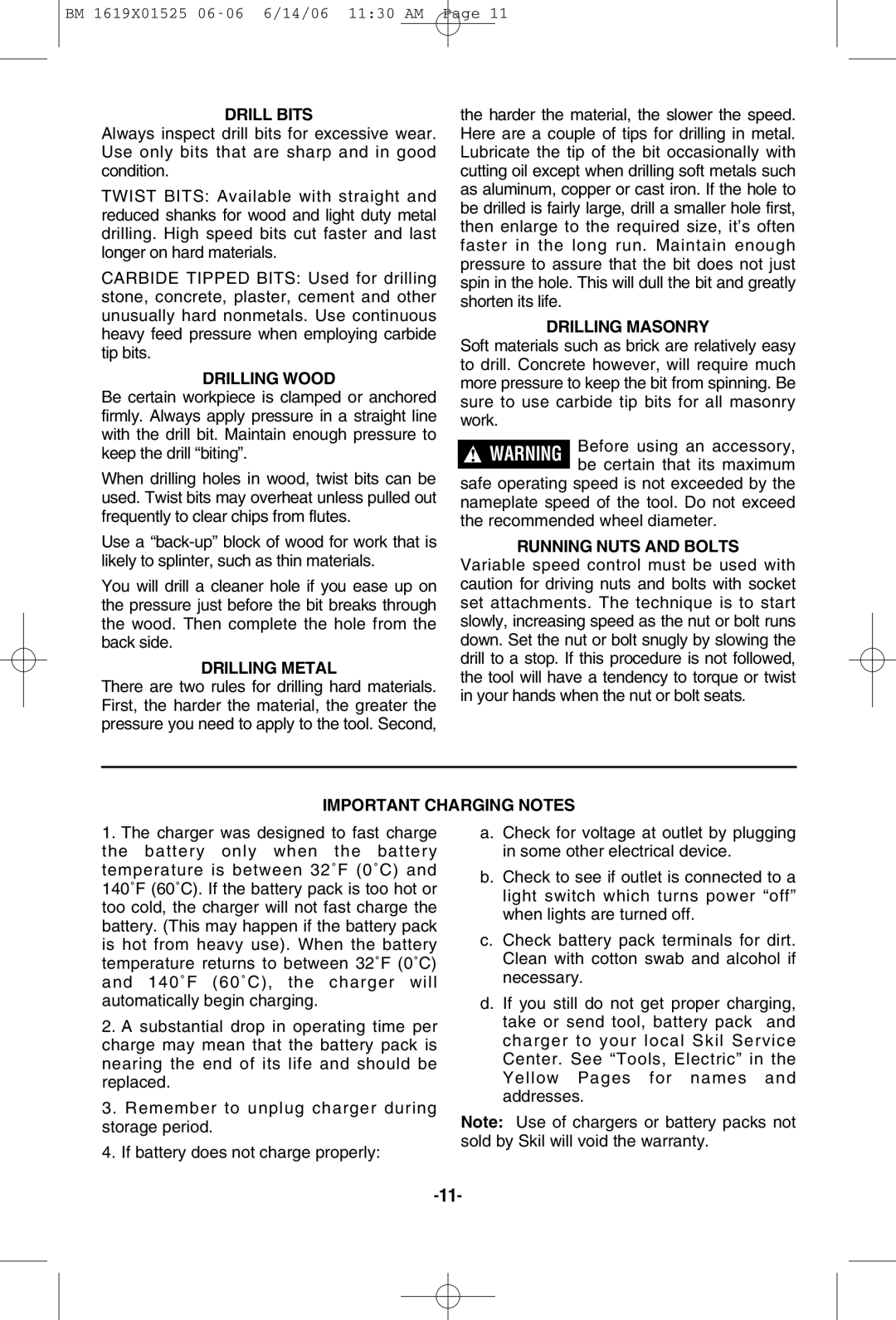
BM 1619X01525
DRILL BITS
Always inspect drill bits for excessive wear. Use only bits that are sharp and in good condition.
TWIST BITS: Available with straight and reduced shanks for wood and light duty metal drilling. High speed bits cut faster and last longer on hard materials.
CARBIDE TIPPED BITS: Used for drilling stone, concrete, plaster, cement and other unusually hard nonmetals. Use continuous heavy feed pressure when employing carbide tip bits.
DRILLING WOOD
Be certain workpiece is clamped or anchored firmly. Always apply pressure in a straight line with the drill bit. Maintain enough pressure to keep the drill “biting”.
When drilling holes in wood, twist bits can be used. Twist bits may overheat unless pulled out frequently to clear chips from flutes.
Use a
You will drill a cleaner hole if you ease up on the pressure just before the bit breaks through the wood. Then complete the hole from the back side.
DRILLING METAL
There are two rules for drilling hard materials. First, the harder the material, the greater the pressure you need to apply to the tool. Second,
the harder the material, the slower the speed. Here are a couple of tips for drilling in metal. Lubricate the tip of the bit occasionally with cutting oil except when drilling soft metals such as aluminum, copper or cast iron. If the hole to be drilled is fairly large, drill a smaller hole first, then enlarge to the required size, it’s often faster in the long run. Maintain enough pressure to assure that the bit does not just spin in the hole. This will dull the bit and greatly shorten its life.
DRILLING MASONRY
Soft materials such as brick are relatively easy to drill. Concrete however, will require much more pressure to keep the bit from spinning. Be sure to use carbide tip bits for all masonry work.
!WARNING Before using an accessory, be certain that its maximum
safe operating speed is not exceeded by the nameplate speed of the tool. Do not exceed the recommended wheel diameter.
RUNNING NUTS AND BOLTS
Variable speed control must be used with caution for driving nuts and bolts with socket set attachments. The technique is to start slowly, increasing speed as the nut or bolt runs down. Set the nut or bolt snugly by slowing the drill to a stop. If this procedure is not followed, the tool will have a tendency to torque or twist in your hands when the nut or bolt seats.
IMPORTANT CHARGING NOTES
1.The charger was designed to fast charge the battery only when the battery temperature is between 32˚F (0˚C) and 140˚F (60˚C). If the battery pack is too hot or too cold, the charger will not fast charge the battery. (This may happen if the battery pack is hot from heavy use). When the battery temperature returns to between 32˚F (0˚C) and 140˚F (60˚C), the charger will automatically begin charging.
2.A substantial drop in operating time per charge may mean that the battery pack is nearing the end of its life and should be replaced.
3.Remember to unplug charger during storage period.
4.If battery does not charge properly:
a.Check for voltage at outlet by plugging in some other electrical device.
b.Check to see if outlet is connected to a light switch which turns power “off” when lights are turned off.
c.Check battery pack terminals for dirt. Clean with cotton swab and alcohol if necessary.
d.If you still do not get proper charging, take or send tool, battery pack and charger to your local Skil Service Center. See “Tools, Electric” in the Yellow Pages for names and addresses.
Note: Use of chargers or battery packs not sold by Skil will void the warranty.
